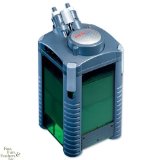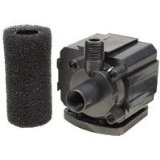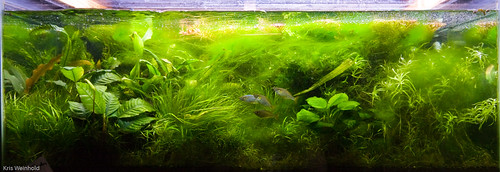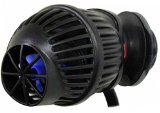Flow: Filters / Powerheads
January 28th, 2009Starting a planted aquarium can seem like a daunting task. Most hobbyists start out small, gradually learning by trial and error what works and what doesn’t, and piece together information from books and websites until they finally either succeed or get frustrated and leave the hobby forever. In this series of posts, I’m going to attempt to outline the most important aspects of setting up a planted aquarium. Hopefully this will become a valuable resource to anyone new to the hobby, or experienced fish-keepers who are looking to setup a planted aquarium.
Flow is one of the most important things to consider when setting up a planted aquarium. As plants use up CO2 and nutrients in the surrounding water, adequate flow ensures that fresh water and nutrients are circulated around the plants so that they can continue growing. Without this, your aquarium can have dead zones where algae adventitiously steps in. To prevent this, add filters and powerheads to your aquarium to clean and circulate the water.
Filtration
While filters do provide circulation within an aquarium, they also perform the task of cleaning the water. There are many different types of filters on the market, but some are much better suited for a planted aquarium than others. Since CO2 is an important addition to any planted aquarium, you should ensure that the filter you choose will not work against this addition. Carbon dioxide can easily be driven out of the aquarium through surface ripples created by equipment. Inherently, hang-on-the-back filters such as the very popular Hagen AquaClear series is ill-suited for a planted aquarium for this reason.
 Canister filters are the ideal filter for a planted aquarium. Not only do they efficiently clean the water due to their ability to easily customize the cleaning medium used (sponges, carbon, bacteria balls, etc…), but their intake and outtake lines can be position well below the water line to prevent surface disturbance. Of course, there are many types of canister filters on the market. I prefer to use filters that will not air-lock when injecting CO2 into their intake, as a means to diffuse the gas into the water column without adding extra CO2 equipment inside of the tank. (A filter with air-locking problems is one where the impeller stalls when a gas is introduced into the impeller chamber.) In addition, most canister filters can easily be hooked up to external heaters, U.V. sterilizers, or other equipment.
Canister filters are the ideal filter for a planted aquarium. Not only do they efficiently clean the water due to their ability to easily customize the cleaning medium used (sponges, carbon, bacteria balls, etc…), but their intake and outtake lines can be position well below the water line to prevent surface disturbance. Of course, there are many types of canister filters on the market. I prefer to use filters that will not air-lock when injecting CO2 into their intake, as a means to diffuse the gas into the water column without adding extra CO2 equipment inside of the tank. (A filter with air-locking problems is one where the impeller stalls when a gas is introduced into the impeller chamber.) In addition, most canister filters can easily be hooked up to external heaters, U.V. sterilizers, or other equipment.
Currently, I successfully use several Eheim Pro II series of canister filters on my aquariums. If you do not plan on injecting CO2 into your filter, virtually any canister filter is appropriate. I’m also successfully using the Hagen Fluval series of filters in this way. When purchasing your filter, it’s often better to buy the next model up for your size of aquarium because when a filter is rated for a certain gallon tank, they generally do not take into account that much of that tank will be obstructed by plant mass.
There are other types of filters that are a little bit less appropriate for the planted aquarium. Sponge filters tend to get plants stuck to them, add too much surface agitation, and do not provide any flow. Additionally, undergravel filters should be avoided as they interfere with plant root systems.
Powerheads
Once you have decided on your filtration method, you may still discover that certain areas of your aquarium are not receiving adequate flow. In these situations, you could add another filter, but it’s usually much less expensive to simply add a powerhead to the aquarium. Powerheads are designed to move a certain amount of water per hour. I’ve recently started using Hydor’s Koralia Powerhead because the design is extremely energy efficient, produces a wide stream, and doesn’t easily clog. There are, however, less conspicuous powerheads on the market that work very well, such as the Hagen AquaClear series. These also have the added benefit of being able to drive a quick filter, which does a great job at clearing micron-level debris from the water column.
Sumps and Pumps
There are other ways to add circulation to your planted aquarium. While, in general, adding a sump (a large hidden aquarium underneath  your visible aquarium to add overall water volume to your system) is not ideal in planted setups, I have seen it done. The key is to make the path from the main aquarium into the sump as smooth as possible so that CO2 is not lost. The benefit of a sump is that you can put extraneous equipment such as your heater down there. You can also dose fertilizers into the sump, and have them dissolve and subsequently migrate back into your main aquarium. A submersible pump, like the Supreme Mag-Drive Utility Pump moves the water back into the main aquarium. These pumps can also be used externally, in conjunction with PVC pipe or hoses to act as an external powerhead. In this way, I have seen some people create a closed-loop from their aquarium through a DIY CO2 reactor, and then back into their aquarium via an external pump. This setup is advantageous if your canister filter does not have enough horsepower to use an external CO2 reactor without losing too much flow.
your visible aquarium to add overall water volume to your system) is not ideal in planted setups, I have seen it done. The key is to make the path from the main aquarium into the sump as smooth as possible so that CO2 is not lost. The benefit of a sump is that you can put extraneous equipment such as your heater down there. You can also dose fertilizers into the sump, and have them dissolve and subsequently migrate back into your main aquarium. A submersible pump, like the Supreme Mag-Drive Utility Pump moves the water back into the main aquarium. These pumps can also be used externally, in conjunction with PVC pipe or hoses to act as an external powerhead. In this way, I have seen some people create a closed-loop from their aquarium through a DIY CO2 reactor, and then back into their aquarium via an external pump. This setup is advantageous if your canister filter does not have enough horsepower to use an external CO2 reactor without losing too much flow.
Summary
In conclusion, having adequate circulation is extremely important in a planted aquarium. There are a number of ways to achieve this, while also accomplishing some other goals, such as filtration, heating, CO2 injection, etc. Hopefully, you now have the knowledge needed to obtain the right circulation system for your planted aquarium.


January 29th, 2009 at 3:22 pm
What do you recommend for the smaller 2.5 gallons? Right now I’m using a tiny water pump that came from one of those “relaxing” table top “zen” fountains (the water dripping sound drove me nuts).
January 29th, 2009 at 11:08 pm
Kim, I have a friend who’s very happy with his Zoo Med 501 Turtle Canister Filter on a nano tank. Otherwise, the Red Sea Nano Deco HOB filter doesn’t create too much water disturbance, so long as you keep topping off the evaporated water.
January 30th, 2009 at 1:06 pm
I’ve read postings by some low-tech, low-budget enthusiasts that you can pull off an undergravel filter in a planted tank, so long as you’re willing to limit your plant species to epiphytes (ferns, anubias, etc., rooted to driftwood) and plants with horizontally-spreading roots (presumably vals and some hygros?) … was wondering what your take on this might be? Obviously, a UGF would also limit your substrate choices even more greatly.
A poster on The Krib web-site wrote that he found a way to use UGFs to control algae: he mounted an upward-facing light system underneath the tank, which encouraged algal growth beneath the filter … apparently this algae out-competed any attempts by other algae to grow above the filter, keeping his plants wonderfully aglae-free. He reported continued success with this for a year, but didn’t post on the topic thereafter … leaving me to wonder whether he was able to sustain this system, or if it crashed.
January 30th, 2009 at 1:44 pm
Mark, just like hang-on-the-back filters, sumps, etc, there are ways to make just about anything work in a planted aquarium. I’m sure the same is true about UGFs, but I’d prefer to not limit myself outright when setting up a tank, as it would be a huge pain to try and reverse that decision later on. There’s also the issue that you generally don’t want a pristine gravel bed in a planted tank. I never vacuum my gravel in the same way fish folks do. I want that mulm and detritus to accumulate as a nutrient source for my plants. Of course, if too much accumulates *on top* of the gravel, I’ll vacuum that up, but the other stuff I want.
As for using UGF’s to control algae, I’d never heard of that. It sounds like an interesting approach, but unlike fish-only aquariums, in planted aquariums you already have something that competes against algae for nutrients — the plants. I mostly subscribe to the philosophy that if you make your plants healthy, your chances are pretty good that they’ll outcompete the algae, and keep your tank looking nice. (Notice I didn’t say algae-free, but pretty close.)
December 5th, 2009 at 2:04 pm
What if you had some sort of co2 injection setup, would that compensate for a hang-on-the-back filter? How significant is the loss of CO2 due to surface ripples caused by these ripples?
December 5th, 2009 at 2:05 pm
*…caused by these filters?*
December 5th, 2009 at 8:28 pm
Caleb, I’m sorry I wasn’t more clear. When talking about the loss of CO2 from the surface ripples of a HOB filter, I’m already assuming that you have a CO2 injection system. Sure, you can setup a CO2 injection system on a tank with a HOB filter, and make a difference, but you’ll be unlikely to achieve the highest CO2 concentrations that are often optimal in a planted aquarium. Beyond that, I always encourage experimentation, so feel free to try it.
That said, when there’s a method that’s proven to work well, I like to steer folks in that direction from the get-go. In this case, I recommend canister filters because they work well with CO2 injection and planted aquariums.
Thanks for you comment!
May 1st, 2014 at 11:27 pm
I am not a proponent of introducing CO2 at the intake side for one reason. Any dissolved gas can be pulled out on the back side of an impellor by the vacuum created. This causes cavitation which takes an eventual toll on the pump. Usually can be heard, and if bad enough, will cause bubbles at the outlet. Instead, use a diffuser design in the exit line to the aquarium. Mine is one that has an impellor driven by the exit water flow. I am sure it will wear out eventually but is cheap to replace, and effective.
May 2nd, 2014 at 6:51 am
Thanks for your feedback Richard! While I haven’t experienced any pump failures from CO2 dissolution on the intake of my Eheim, I can understand the possibility. There definitely a less noise and pressure on the impeller if you use an atomizer strainer so that only micro-bubbles go through the filter. Of course, if you’re doing that, you can also use an in-line regulator or atomizer on the outtake of the canister filter like you suggest. I prefer any of those methods to adding a diffuser in the tank though.